Assignment on Consumer Buying Behaviour
VerifiedAdded on 2022/08/26
|22
|2248
|24
AI Summary
Contribute Materials
Your contribution can guide someone’s learning journey. Share your
documents today.
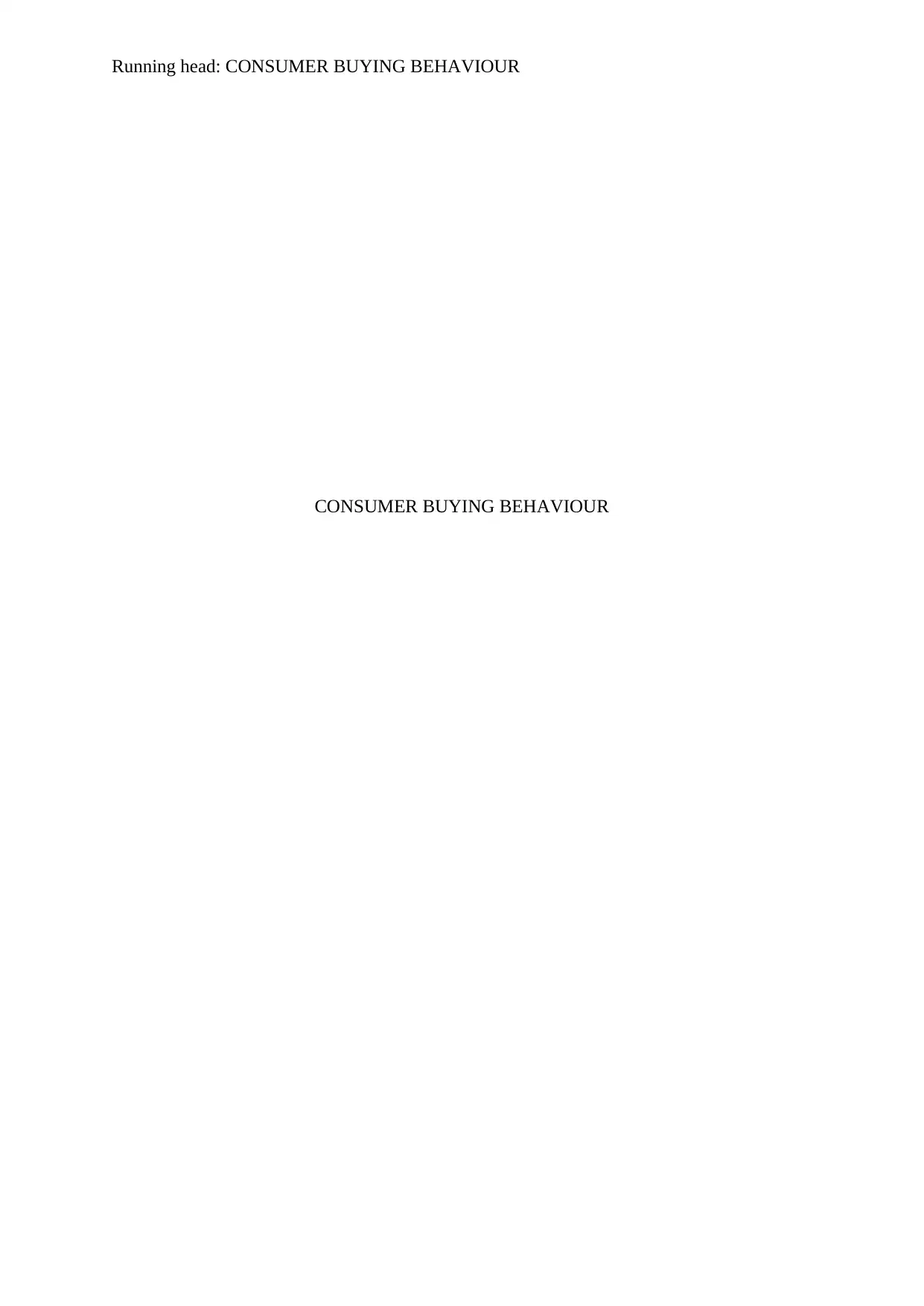
Running head: CONSUMER BUYING BEHAVIOUR
CONSUMER BUYING BEHAVIOUR
CONSUMER BUYING BEHAVIOUR
Secure Best Marks with AI Grader
Need help grading? Try our AI Grader for instant feedback on your assignments.
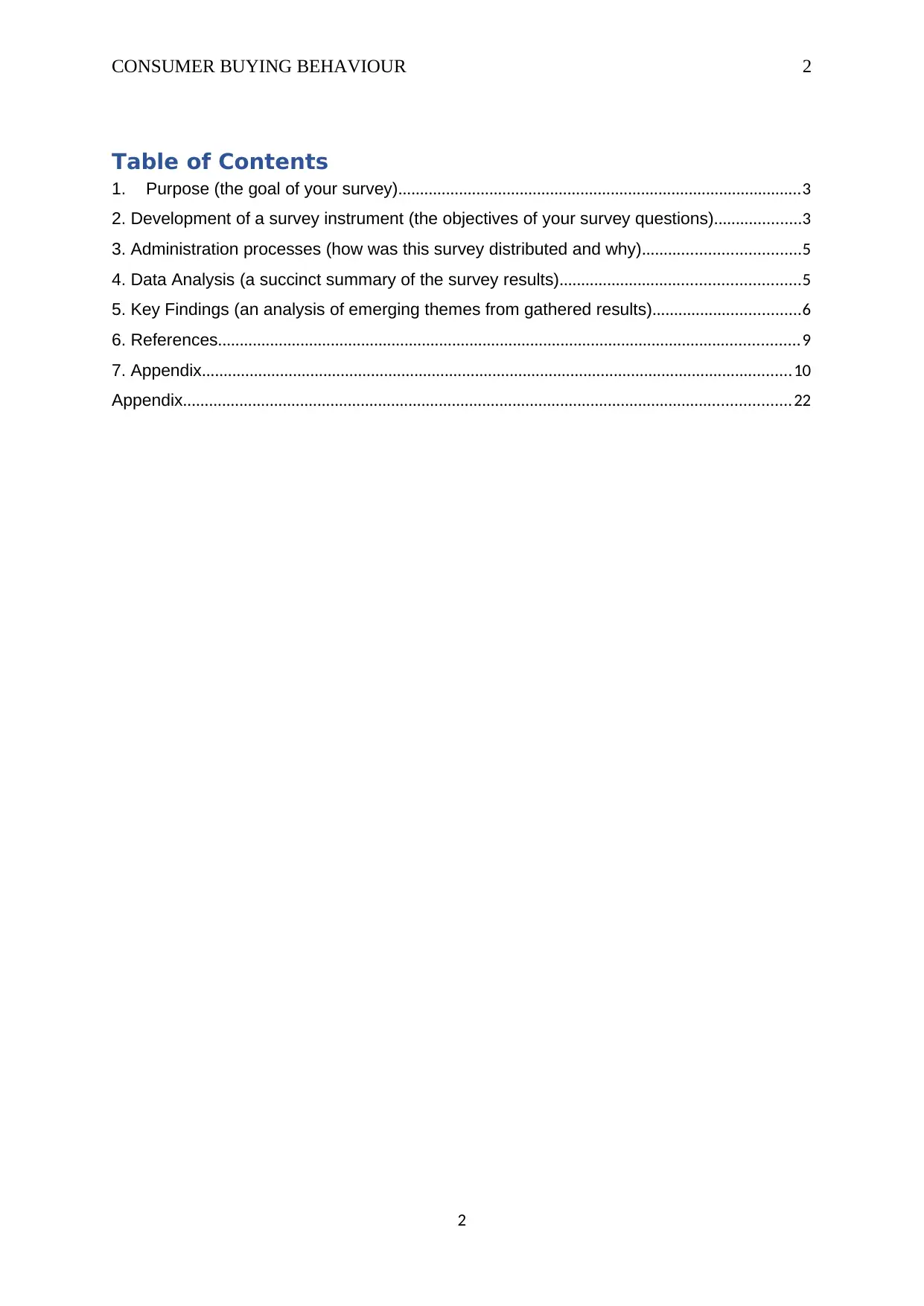
CONSUMER BUYING BEHAVIOUR 2
Table of Contents
1. Purpose (the goal of your survey).............................................................................................3
2. Development of a survey instrument (the objectives of your survey questions)....................3
3. Administration processes (how was this survey distributed and why)....................................5
4. Data Analysis (a succinct summary of the survey results).......................................................5
5. Key Findings (an analysis of emerging themes from gathered results)..................................6
6. References......................................................................................................................................9
7. Appendix........................................................................................................................................10
Appendix............................................................................................................................................22
2
Table of Contents
1. Purpose (the goal of your survey).............................................................................................3
2. Development of a survey instrument (the objectives of your survey questions)....................3
3. Administration processes (how was this survey distributed and why)....................................5
4. Data Analysis (a succinct summary of the survey results).......................................................5
5. Key Findings (an analysis of emerging themes from gathered results)..................................6
6. References......................................................................................................................................9
7. Appendix........................................................................................................................................10
Appendix............................................................................................................................................22
2
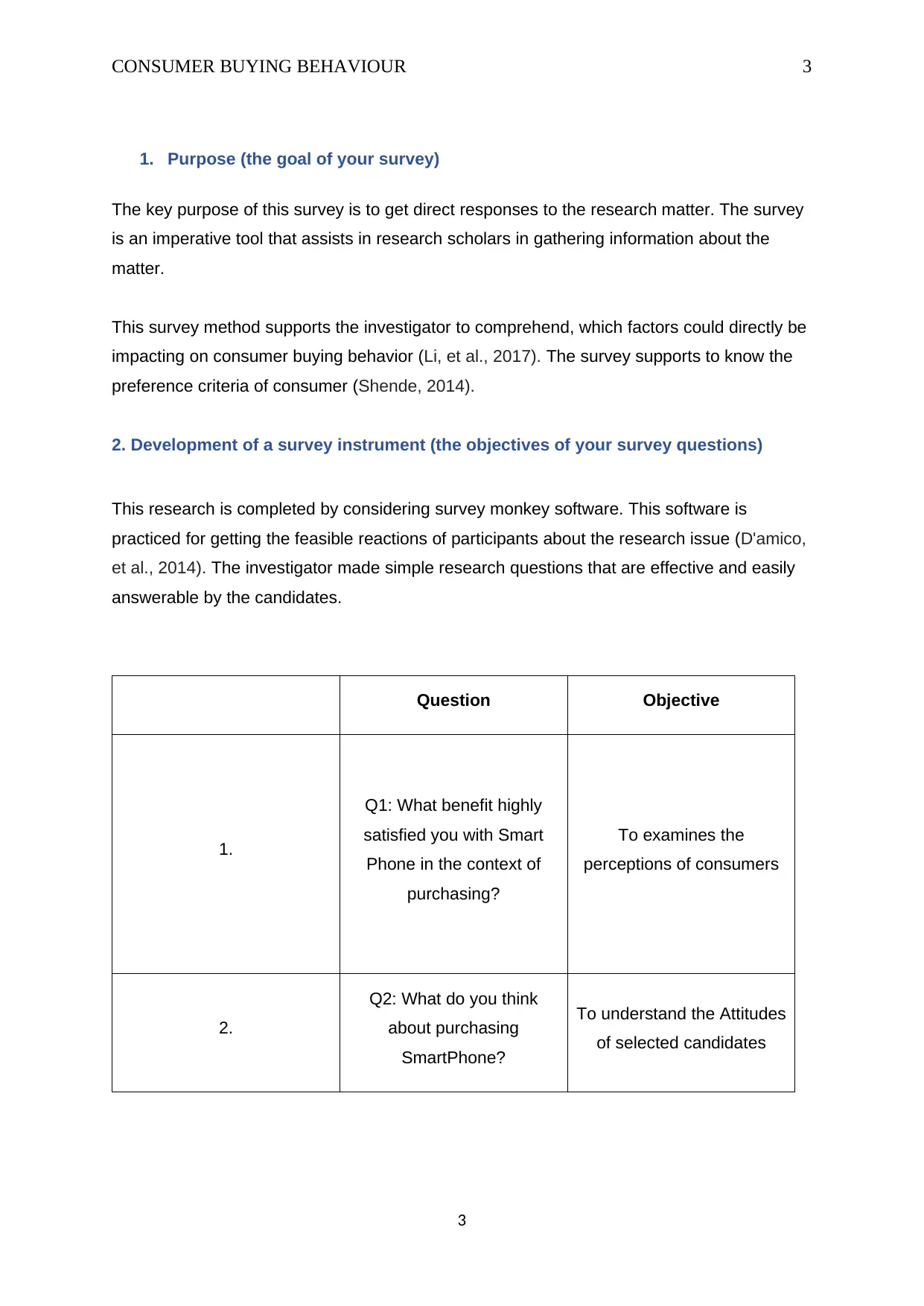
CONSUMER BUYING BEHAVIOUR 3
1. Purpose (the goal of your survey)
The key purpose of this survey is to get direct responses to the research matter. The survey
is an imperative tool that assists in research scholars in gathering information about the
matter.
This survey method supports the investigator to comprehend, which factors could directly be
impacting on consumer buying behavior (Li, et al., 2017). The survey supports to know the
preference criteria of consumer (Shende, 2014).
2. Development of a survey instrument (the objectives of your survey questions)
This research is completed by considering survey monkey software. This software is
practiced for getting the feasible reactions of participants about the research issue (D'amico,
et al., 2014). The investigator made simple research questions that are effective and easily
answerable by the candidates.
Question Objective
1.
Q1: What benefit highly
satisfied you with Smart
Phone in the context of
purchasing?
To examines the
perceptions of consumers
2.
Q2: What do you think
about purchasing
SmartPhone?
To understand the Attitudes
of selected candidates
3
1. Purpose (the goal of your survey)
The key purpose of this survey is to get direct responses to the research matter. The survey
is an imperative tool that assists in research scholars in gathering information about the
matter.
This survey method supports the investigator to comprehend, which factors could directly be
impacting on consumer buying behavior (Li, et al., 2017). The survey supports to know the
preference criteria of consumer (Shende, 2014).
2. Development of a survey instrument (the objectives of your survey questions)
This research is completed by considering survey monkey software. This software is
practiced for getting the feasible reactions of participants about the research issue (D'amico,
et al., 2014). The investigator made simple research questions that are effective and easily
answerable by the candidates.
Question Objective
1.
Q1: What benefit highly
satisfied you with Smart
Phone in the context of
purchasing?
To examines the
perceptions of consumers
2.
Q2: What do you think
about purchasing
SmartPhone?
To understand the Attitudes
of selected candidates
3
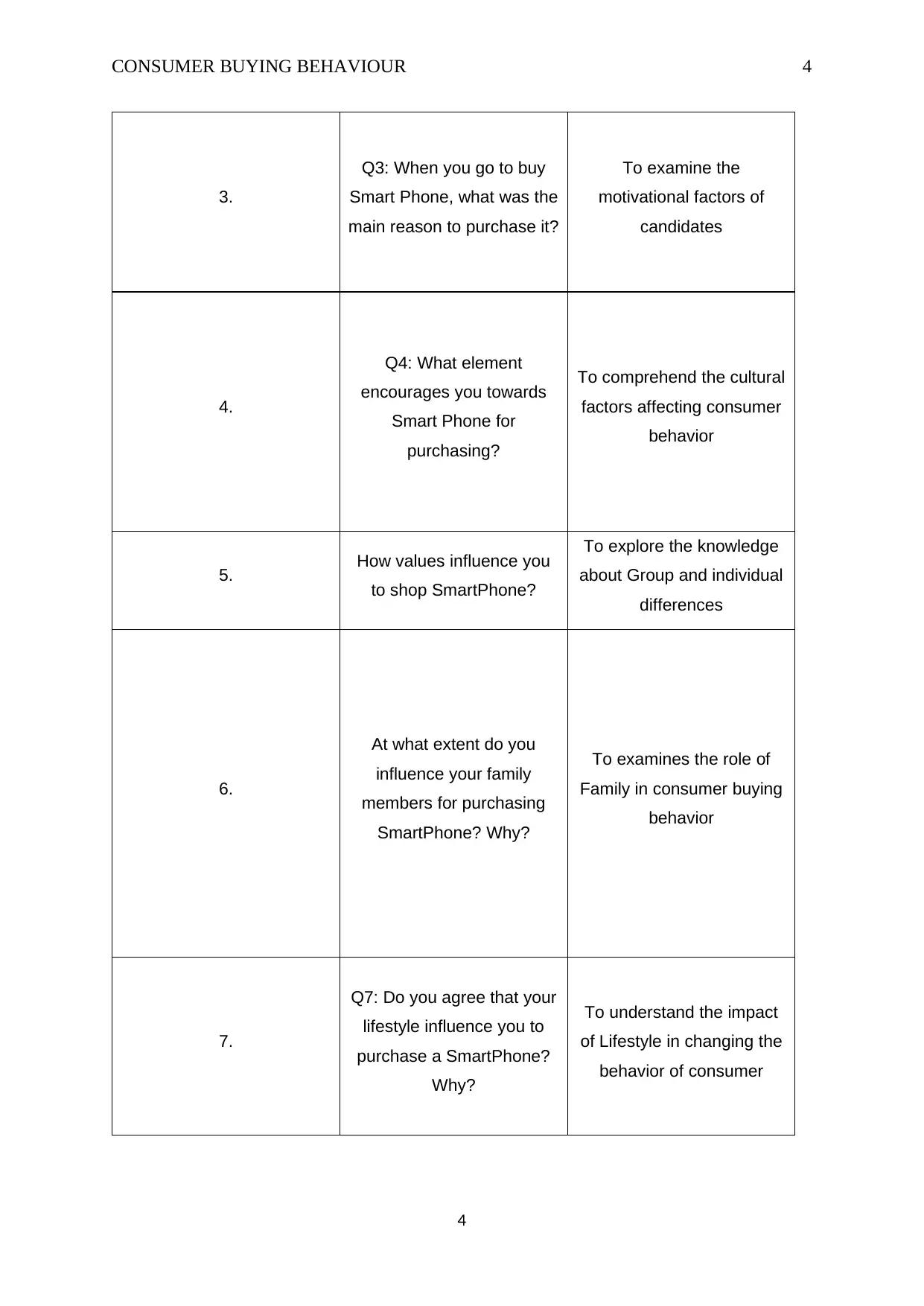
CONSUMER BUYING BEHAVIOUR 4
3.
Q3: When you go to buy
Smart Phone, what was the
main reason to purchase it?
To examine the
motivational factors of
candidates
4.
Q4: What element
encourages you towards
Smart Phone for
purchasing?
To comprehend the cultural
factors affecting consumer
behavior
5. How values influence you
to shop SmartPhone?
To explore the knowledge
about Group and individual
differences
6.
At what extent do you
influence your family
members for purchasing
SmartPhone? Why?
To examines the role of
Family in consumer buying
behavior
7.
Q7: Do you agree that your
lifestyle influence you to
purchase a SmartPhone?
Why?
To understand the impact
of Lifestyle in changing the
behavior of consumer
4
3.
Q3: When you go to buy
Smart Phone, what was the
main reason to purchase it?
To examine the
motivational factors of
candidates
4.
Q4: What element
encourages you towards
Smart Phone for
purchasing?
To comprehend the cultural
factors affecting consumer
behavior
5. How values influence you
to shop SmartPhone?
To explore the knowledge
about Group and individual
differences
6.
At what extent do you
influence your family
members for purchasing
SmartPhone? Why?
To examines the role of
Family in consumer buying
behavior
7.
Q7: Do you agree that your
lifestyle influence you to
purchase a SmartPhone?
Why?
To understand the impact
of Lifestyle in changing the
behavior of consumer
4
Secure Best Marks with AI Grader
Need help grading? Try our AI Grader for instant feedback on your assignments.
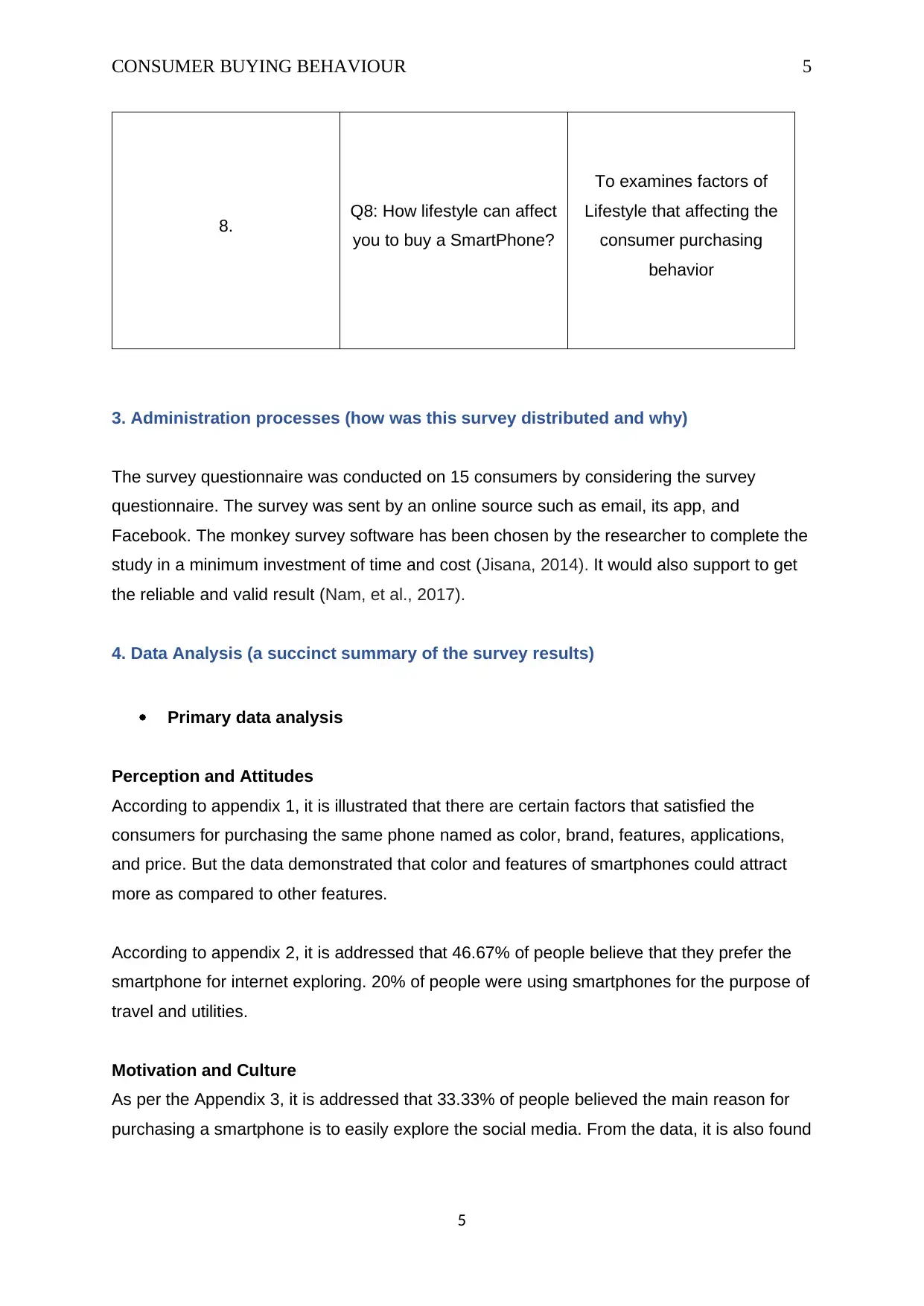
CONSUMER BUYING BEHAVIOUR 5
8. Q8: How lifestyle can affect
you to buy a SmartPhone?
To examines factors of
Lifestyle that affecting the
consumer purchasing
behavior
3. Administration processes (how was this survey distributed and why)
The survey questionnaire was conducted on 15 consumers by considering the survey
questionnaire. The survey was sent by an online source such as email, its app, and
Facebook. The monkey survey software has been chosen by the researcher to complete the
study in a minimum investment of time and cost (Jisana, 2014). It would also support to get
the reliable and valid result (Nam, et al., 2017).
4. Data Analysis (a succinct summary of the survey results)
Primary data analysis
Perception and Attitudes
According to appendix 1, it is illustrated that there are certain factors that satisfied the
consumers for purchasing the same phone named as color, brand, features, applications,
and price. But the data demonstrated that color and features of smartphones could attract
more as compared to other features.
According to appendix 2, it is addressed that 46.67% of people believe that they prefer the
smartphone for internet exploring. 20% of people were using smartphones for the purpose of
travel and utilities.
Motivation and Culture
As per the Appendix 3, it is addressed that 33.33% of people believed the main reason for
purchasing a smartphone is to easily explore the social media. From the data, it is also found
5
8. Q8: How lifestyle can affect
you to buy a SmartPhone?
To examines factors of
Lifestyle that affecting the
consumer purchasing
behavior
3. Administration processes (how was this survey distributed and why)
The survey questionnaire was conducted on 15 consumers by considering the survey
questionnaire. The survey was sent by an online source such as email, its app, and
Facebook. The monkey survey software has been chosen by the researcher to complete the
study in a minimum investment of time and cost (Jisana, 2014). It would also support to get
the reliable and valid result (Nam, et al., 2017).
4. Data Analysis (a succinct summary of the survey results)
Primary data analysis
Perception and Attitudes
According to appendix 1, it is illustrated that there are certain factors that satisfied the
consumers for purchasing the same phone named as color, brand, features, applications,
and price. But the data demonstrated that color and features of smartphones could attract
more as compared to other features.
According to appendix 2, it is addressed that 46.67% of people believe that they prefer the
smartphone for internet exploring. 20% of people were using smartphones for the purpose of
travel and utilities.
Motivation and Culture
As per the Appendix 3, it is addressed that 33.33% of people believed the main reason for
purchasing a smartphone is to easily explore the social media. From the data, it is also found
5
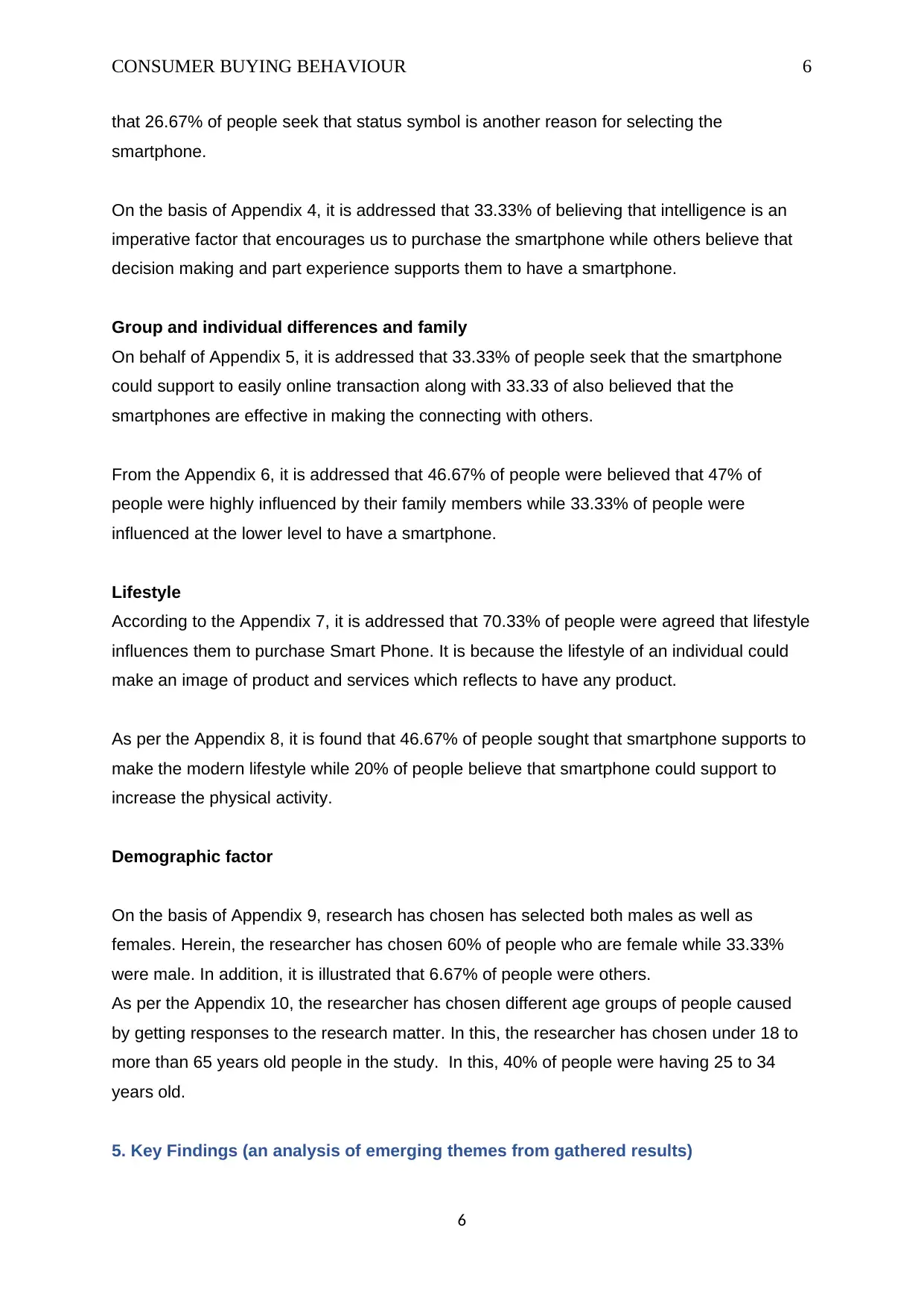
CONSUMER BUYING BEHAVIOUR 6
that 26.67% of people seek that status symbol is another reason for selecting the
smartphone.
On the basis of Appendix 4, it is addressed that 33.33% of believing that intelligence is an
imperative factor that encourages us to purchase the smartphone while others believe that
decision making and part experience supports them to have a smartphone.
Group and individual differences and family
On behalf of Appendix 5, it is addressed that 33.33% of people seek that the smartphone
could support to easily online transaction along with 33.33 of also believed that the
smartphones are effective in making the connecting with others.
From the Appendix 6, it is addressed that 46.67% of people were believed that 47% of
people were highly influenced by their family members while 33.33% of people were
influenced at the lower level to have a smartphone.
Lifestyle
According to the Appendix 7, it is addressed that 70.33% of people were agreed that lifestyle
influences them to purchase Smart Phone. It is because the lifestyle of an individual could
make an image of product and services which reflects to have any product.
As per the Appendix 8, it is found that 46.67% of people sought that smartphone supports to
make the modern lifestyle while 20% of people believe that smartphone could support to
increase the physical activity.
Demographic factor
On the basis of Appendix 9, research has chosen has selected both males as well as
females. Herein, the researcher has chosen 60% of people who are female while 33.33%
were male. In addition, it is illustrated that 6.67% of people were others.
As per the Appendix 10, the researcher has chosen different age groups of people caused
by getting responses to the research matter. In this, the researcher has chosen under 18 to
more than 65 years old people in the study. In this, 40% of people were having 25 to 34
years old.
5. Key Findings (an analysis of emerging themes from gathered results)
6
that 26.67% of people seek that status symbol is another reason for selecting the
smartphone.
On the basis of Appendix 4, it is addressed that 33.33% of believing that intelligence is an
imperative factor that encourages us to purchase the smartphone while others believe that
decision making and part experience supports them to have a smartphone.
Group and individual differences and family
On behalf of Appendix 5, it is addressed that 33.33% of people seek that the smartphone
could support to easily online transaction along with 33.33 of also believed that the
smartphones are effective in making the connecting with others.
From the Appendix 6, it is addressed that 46.67% of people were believed that 47% of
people were highly influenced by their family members while 33.33% of people were
influenced at the lower level to have a smartphone.
Lifestyle
According to the Appendix 7, it is addressed that 70.33% of people were agreed that lifestyle
influences them to purchase Smart Phone. It is because the lifestyle of an individual could
make an image of product and services which reflects to have any product.
As per the Appendix 8, it is found that 46.67% of people sought that smartphone supports to
make the modern lifestyle while 20% of people believe that smartphone could support to
increase the physical activity.
Demographic factor
On the basis of Appendix 9, research has chosen has selected both males as well as
females. Herein, the researcher has chosen 60% of people who are female while 33.33%
were male. In addition, it is illustrated that 6.67% of people were others.
As per the Appendix 10, the researcher has chosen different age groups of people caused
by getting responses to the research matter. In this, the researcher has chosen under 18 to
more than 65 years old people in the study. In this, 40% of people were having 25 to 34
years old.
5. Key Findings (an analysis of emerging themes from gathered results)
6
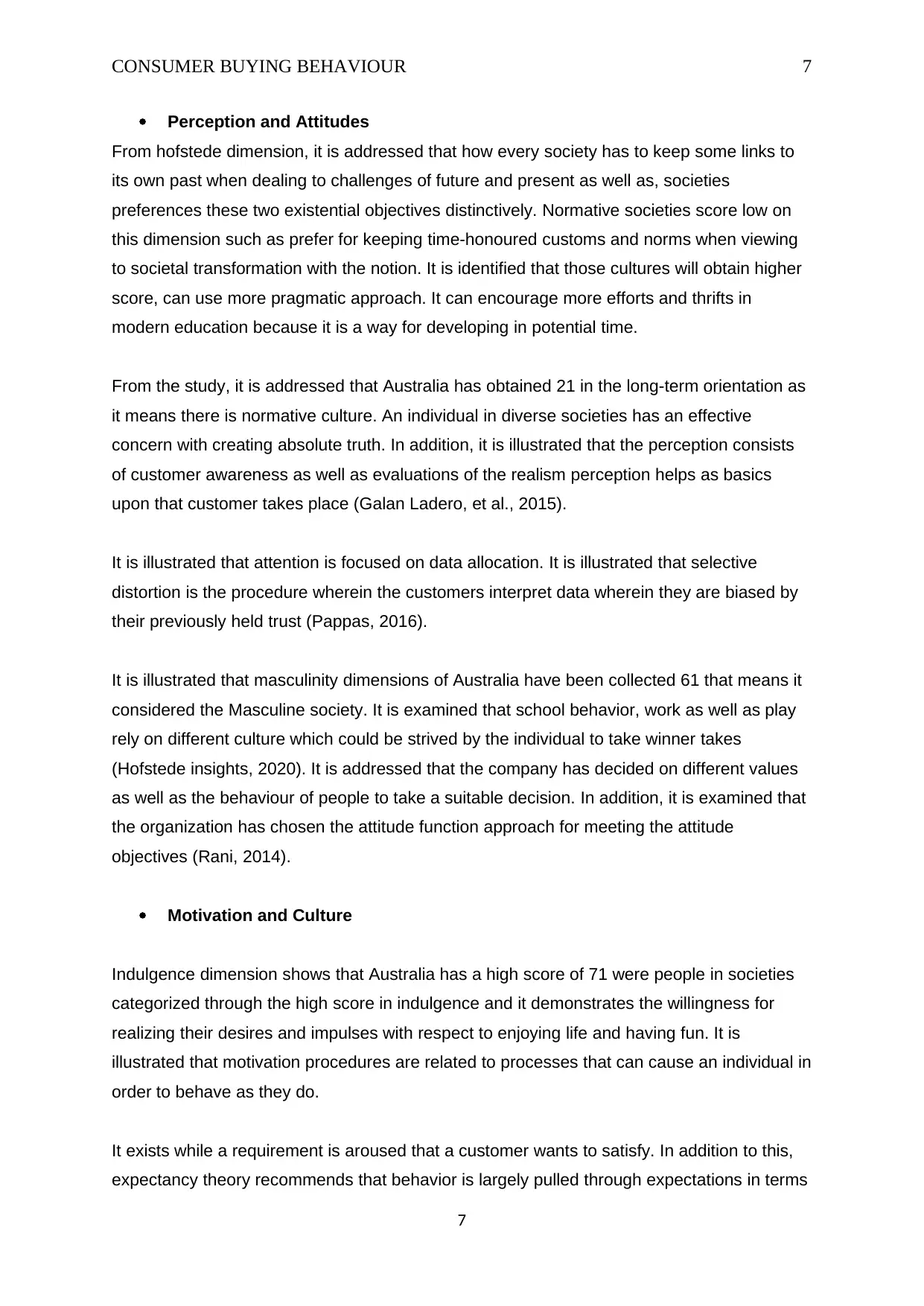
CONSUMER BUYING BEHAVIOUR 7
Perception and Attitudes
From hofstede dimension, it is addressed that how every society has to keep some links to
its own past when dealing to challenges of future and present as well as, societies
preferences these two existential objectives distinctively. Normative societies score low on
this dimension such as prefer for keeping time-honoured customs and norms when viewing
to societal transformation with the notion. It is identified that those cultures will obtain higher
score, can use more pragmatic approach. It can encourage more efforts and thrifts in
modern education because it is a way for developing in potential time.
From the study, it is addressed that Australia has obtained 21 in the long-term orientation as
it means there is normative culture. An individual in diverse societies has an effective
concern with creating absolute truth. In addition, it is illustrated that the perception consists
of customer awareness as well as evaluations of the realism perception helps as basics
upon that customer takes place (Galan Ladero, et al., 2015).
It is illustrated that attention is focused on data allocation. It is illustrated that selective
distortion is the procedure wherein the customers interpret data wherein they are biased by
their previously held trust (Pappas, 2016).
It is illustrated that masculinity dimensions of Australia have been collected 61 that means it
considered the Masculine society. It is examined that school behavior, work as well as play
rely on different culture which could be strived by the individual to take winner takes
(Hofstede insights, 2020). It is addressed that the company has decided on different values
as well as the behaviour of people to take a suitable decision. In addition, it is examined that
the organization has chosen the attitude function approach for meeting the attitude
objectives (Rani, 2014).
Motivation and Culture
Indulgence dimension shows that Australia has a high score of 71 were people in societies
categorized through the high score in indulgence and it demonstrates the willingness for
realizing their desires and impulses with respect to enjoying life and having fun. It is
illustrated that motivation procedures are related to processes that can cause an individual in
order to behave as they do.
It exists while a requirement is aroused that a customer wants to satisfy. In addition to this,
expectancy theory recommends that behavior is largely pulled through expectations in terms
7
Perception and Attitudes
From hofstede dimension, it is addressed that how every society has to keep some links to
its own past when dealing to challenges of future and present as well as, societies
preferences these two existential objectives distinctively. Normative societies score low on
this dimension such as prefer for keeping time-honoured customs and norms when viewing
to societal transformation with the notion. It is identified that those cultures will obtain higher
score, can use more pragmatic approach. It can encourage more efforts and thrifts in
modern education because it is a way for developing in potential time.
From the study, it is addressed that Australia has obtained 21 in the long-term orientation as
it means there is normative culture. An individual in diverse societies has an effective
concern with creating absolute truth. In addition, it is illustrated that the perception consists
of customer awareness as well as evaluations of the realism perception helps as basics
upon that customer takes place (Galan Ladero, et al., 2015).
It is illustrated that attention is focused on data allocation. It is illustrated that selective
distortion is the procedure wherein the customers interpret data wherein they are biased by
their previously held trust (Pappas, 2016).
It is illustrated that masculinity dimensions of Australia have been collected 61 that means it
considered the Masculine society. It is examined that school behavior, work as well as play
rely on different culture which could be strived by the individual to take winner takes
(Hofstede insights, 2020). It is addressed that the company has decided on different values
as well as the behaviour of people to take a suitable decision. In addition, it is examined that
the organization has chosen the attitude function approach for meeting the attitude
objectives (Rani, 2014).
Motivation and Culture
Indulgence dimension shows that Australia has a high score of 71 were people in societies
categorized through the high score in indulgence and it demonstrates the willingness for
realizing their desires and impulses with respect to enjoying life and having fun. It is
illustrated that motivation procedures are related to processes that can cause an individual in
order to behave as they do.
It exists while a requirement is aroused that a customer wants to satisfy. In addition to this,
expectancy theory recommends that behavior is largely pulled through expectations in terms
7
Paraphrase This Document
Need a fresh take? Get an instant paraphrase of this document with our AI Paraphraser
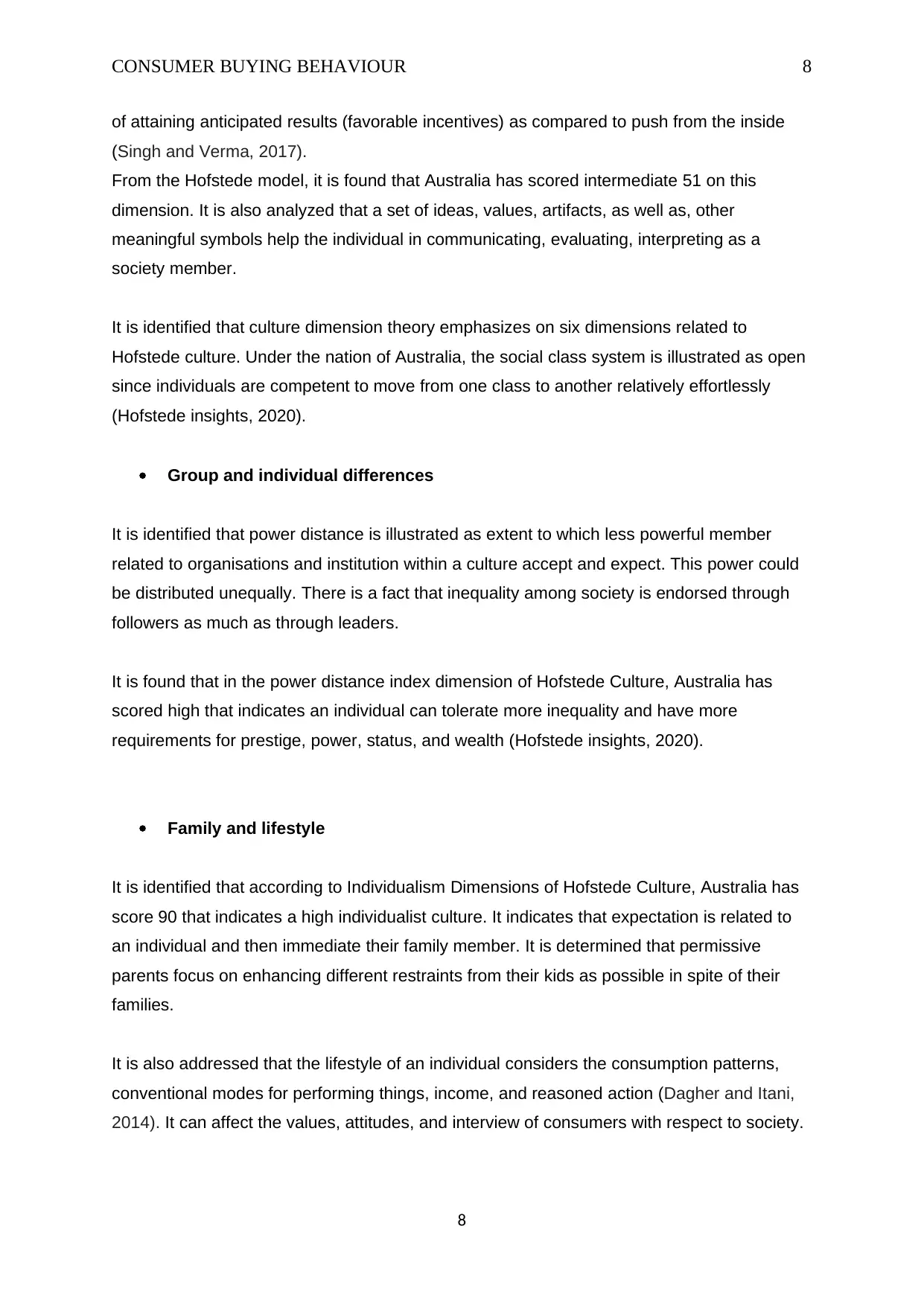
CONSUMER BUYING BEHAVIOUR 8
of attaining anticipated results (favorable incentives) as compared to push from the inside
(Singh and Verma, 2017).
From the Hofstede model, it is found that Australia has scored intermediate 51 on this
dimension. It is also analyzed that a set of ideas, values, artifacts, as well as, other
meaningful symbols help the individual in communicating, evaluating, interpreting as a
society member.
It is identified that culture dimension theory emphasizes on six dimensions related to
Hofstede culture. Under the nation of Australia, the social class system is illustrated as open
since individuals are competent to move from one class to another relatively effortlessly
(Hofstede insights, 2020).
Group and individual differences
It is identified that power distance is illustrated as extent to which less powerful member
related to organisations and institution within a culture accept and expect. This power could
be distributed unequally. There is a fact that inequality among society is endorsed through
followers as much as through leaders.
It is found that in the power distance index dimension of Hofstede Culture, Australia has
scored high that indicates an individual can tolerate more inequality and have more
requirements for prestige, power, status, and wealth (Hofstede insights, 2020).
Family and lifestyle
It is identified that according to Individualism Dimensions of Hofstede Culture, Australia has
score 90 that indicates a high individualist culture. It indicates that expectation is related to
an individual and then immediate their family member. It is determined that permissive
parents focus on enhancing different restraints from their kids as possible in spite of their
families.
It is also addressed that the lifestyle of an individual considers the consumption patterns,
conventional modes for performing things, income, and reasoned action (Dagher and Itani,
2014). It can affect the values, attitudes, and interview of consumers with respect to society.
8
of attaining anticipated results (favorable incentives) as compared to push from the inside
(Singh and Verma, 2017).
From the Hofstede model, it is found that Australia has scored intermediate 51 on this
dimension. It is also analyzed that a set of ideas, values, artifacts, as well as, other
meaningful symbols help the individual in communicating, evaluating, interpreting as a
society member.
It is identified that culture dimension theory emphasizes on six dimensions related to
Hofstede culture. Under the nation of Australia, the social class system is illustrated as open
since individuals are competent to move from one class to another relatively effortlessly
(Hofstede insights, 2020).
Group and individual differences
It is identified that power distance is illustrated as extent to which less powerful member
related to organisations and institution within a culture accept and expect. This power could
be distributed unequally. There is a fact that inequality among society is endorsed through
followers as much as through leaders.
It is found that in the power distance index dimension of Hofstede Culture, Australia has
scored high that indicates an individual can tolerate more inequality and have more
requirements for prestige, power, status, and wealth (Hofstede insights, 2020).
Family and lifestyle
It is identified that according to Individualism Dimensions of Hofstede Culture, Australia has
score 90 that indicates a high individualist culture. It indicates that expectation is related to
an individual and then immediate their family member. It is determined that permissive
parents focus on enhancing different restraints from their kids as possible in spite of their
families.
It is also addressed that the lifestyle of an individual considers the consumption patterns,
conventional modes for performing things, income, and reasoned action (Dagher and Itani,
2014). It can affect the values, attitudes, and interview of consumers with respect to society.
8
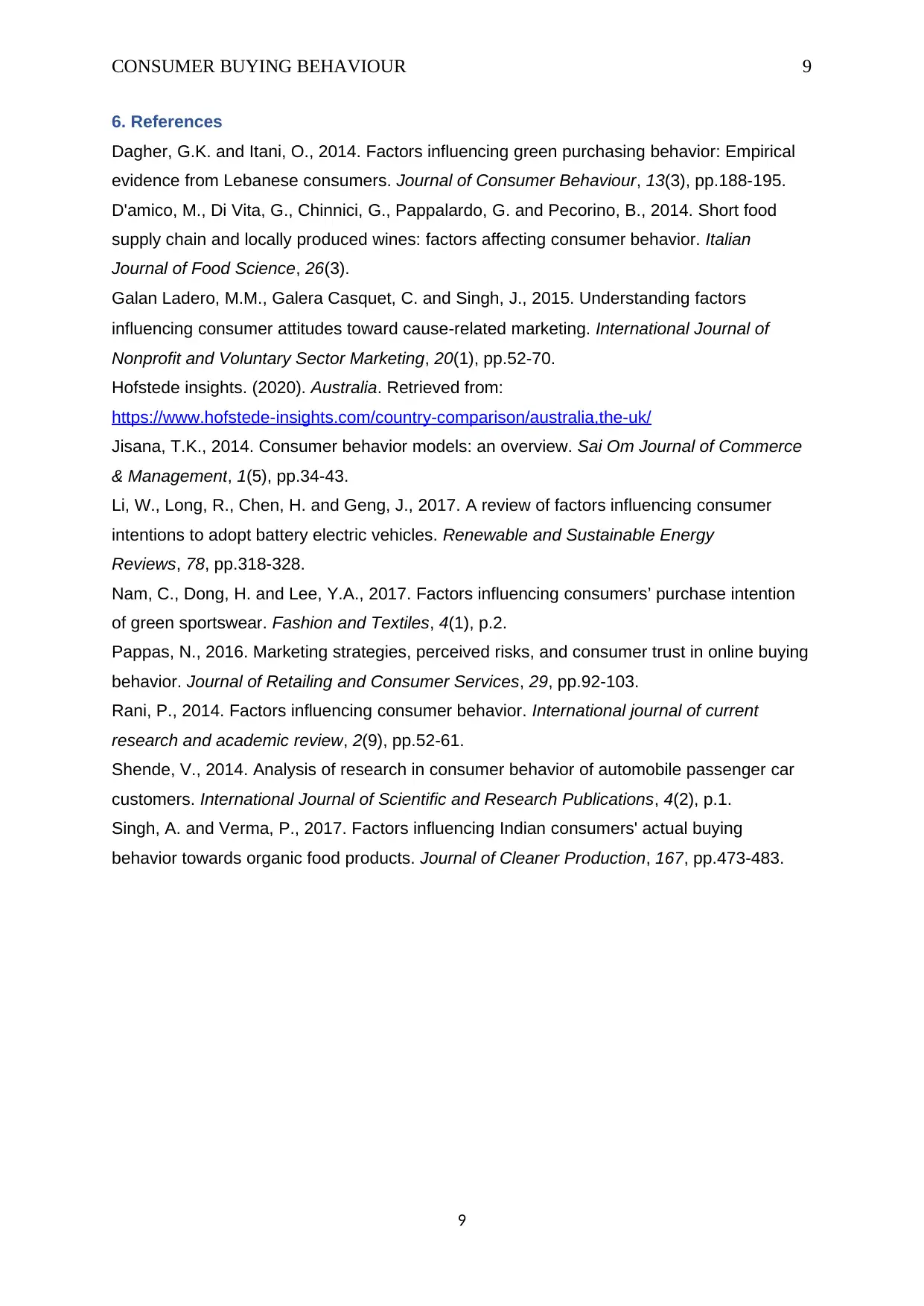
CONSUMER BUYING BEHAVIOUR 9
6. References
Dagher, G.K. and Itani, O., 2014. Factors influencing green purchasing behavior: Empirical
evidence from Lebanese consumers. Journal of Consumer Behaviour, 13(3), pp.188-195.
D'amico, M., Di Vita, G., Chinnici, G., Pappalardo, G. and Pecorino, B., 2014. Short food
supply chain and locally produced wines: factors affecting consumer behavior. Italian
Journal of Food Science, 26(3).
Galan Ladero, M.M., Galera Casquet, C. and Singh, J., 2015. Understanding factors
influencing consumer attitudes toward cause‐related marketing. International Journal of
Nonprofit and Voluntary Sector Marketing, 20(1), pp.52-70.
Hofstede insights. (2020). Australia. Retrieved from:
https://www.hofstede-insights.com/country-comparison/australia,the-uk/
Jisana, T.K., 2014. Consumer behavior models: an overview. Sai Om Journal of Commerce
& Management, 1(5), pp.34-43.
Li, W., Long, R., Chen, H. and Geng, J., 2017. A review of factors influencing consumer
intentions to adopt battery electric vehicles. Renewable and Sustainable Energy
Reviews, 78, pp.318-328.
Nam, C., Dong, H. and Lee, Y.A., 2017. Factors influencing consumers’ purchase intention
of green sportswear. Fashion and Textiles, 4(1), p.2.
Pappas, N., 2016. Marketing strategies, perceived risks, and consumer trust in online buying
behavior. Journal of Retailing and Consumer Services, 29, pp.92-103.
Rani, P., 2014. Factors influencing consumer behavior. International journal of current
research and academic review, 2(9), pp.52-61.
Shende, V., 2014. Analysis of research in consumer behavior of automobile passenger car
customers. International Journal of Scientific and Research Publications, 4(2), p.1.
Singh, A. and Verma, P., 2017. Factors influencing Indian consumers' actual buying
behavior towards organic food products. Journal of Cleaner Production, 167, pp.473-483.
9
6. References
Dagher, G.K. and Itani, O., 2014. Factors influencing green purchasing behavior: Empirical
evidence from Lebanese consumers. Journal of Consumer Behaviour, 13(3), pp.188-195.
D'amico, M., Di Vita, G., Chinnici, G., Pappalardo, G. and Pecorino, B., 2014. Short food
supply chain and locally produced wines: factors affecting consumer behavior. Italian
Journal of Food Science, 26(3).
Galan Ladero, M.M., Galera Casquet, C. and Singh, J., 2015. Understanding factors
influencing consumer attitudes toward cause‐related marketing. International Journal of
Nonprofit and Voluntary Sector Marketing, 20(1), pp.52-70.
Hofstede insights. (2020). Australia. Retrieved from:
https://www.hofstede-insights.com/country-comparison/australia,the-uk/
Jisana, T.K., 2014. Consumer behavior models: an overview. Sai Om Journal of Commerce
& Management, 1(5), pp.34-43.
Li, W., Long, R., Chen, H. and Geng, J., 2017. A review of factors influencing consumer
intentions to adopt battery electric vehicles. Renewable and Sustainable Energy
Reviews, 78, pp.318-328.
Nam, C., Dong, H. and Lee, Y.A., 2017. Factors influencing consumers’ purchase intention
of green sportswear. Fashion and Textiles, 4(1), p.2.
Pappas, N., 2016. Marketing strategies, perceived risks, and consumer trust in online buying
behavior. Journal of Retailing and Consumer Services, 29, pp.92-103.
Rani, P., 2014. Factors influencing consumer behavior. International journal of current
research and academic review, 2(9), pp.52-61.
Shende, V., 2014. Analysis of research in consumer behavior of automobile passenger car
customers. International Journal of Scientific and Research Publications, 4(2), p.1.
Singh, A. and Verma, P., 2017. Factors influencing Indian consumers' actual buying
behavior towards organic food products. Journal of Cleaner Production, 167, pp.473-483.
9
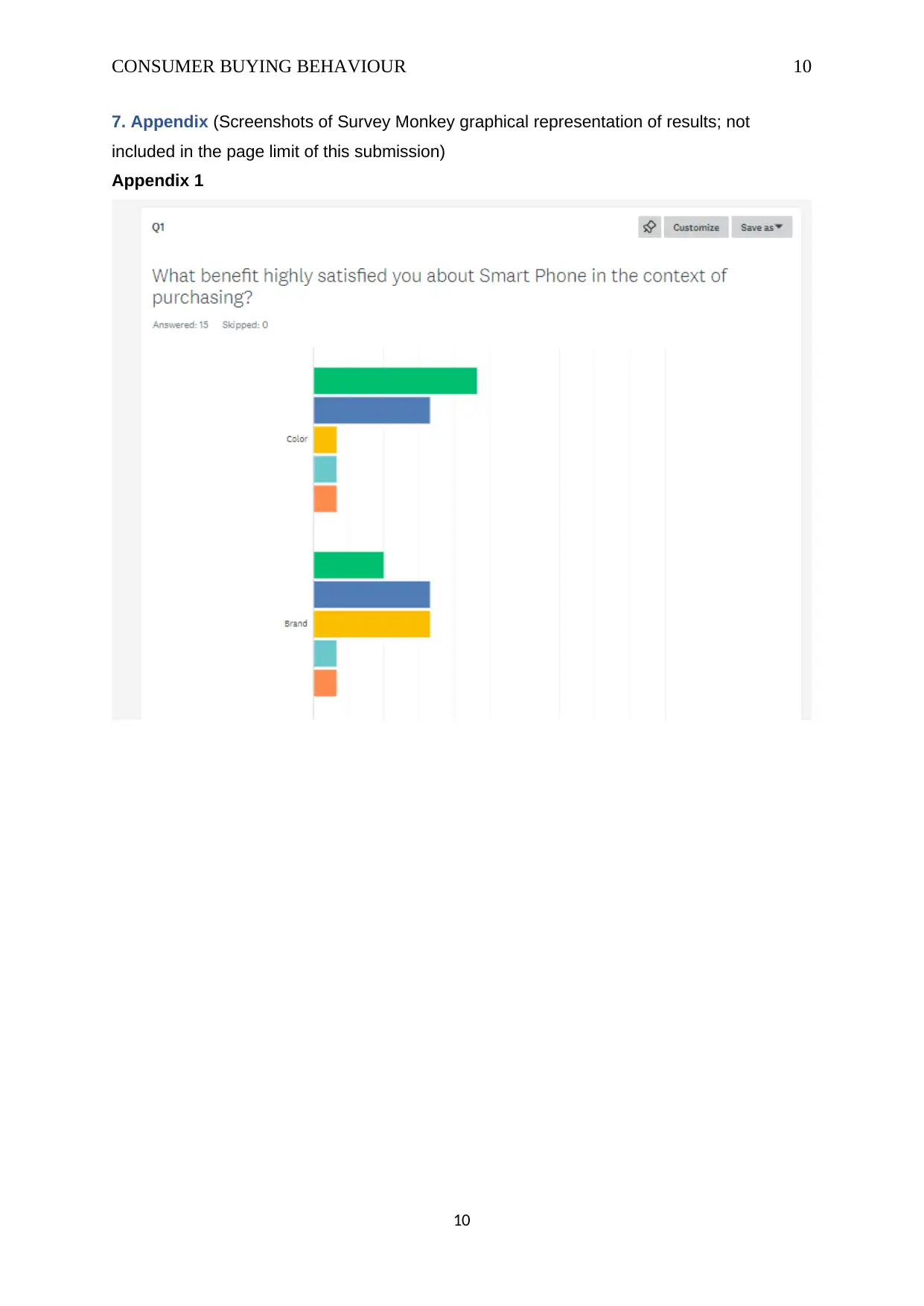
CONSUMER BUYING BEHAVIOUR 10
7. Appendix (Screenshots of Survey Monkey graphical representation of results; not
included in the page limit of this submission)
Appendix 1
10
7. Appendix (Screenshots of Survey Monkey graphical representation of results; not
included in the page limit of this submission)
Appendix 1
10
Secure Best Marks with AI Grader
Need help grading? Try our AI Grader for instant feedback on your assignments.
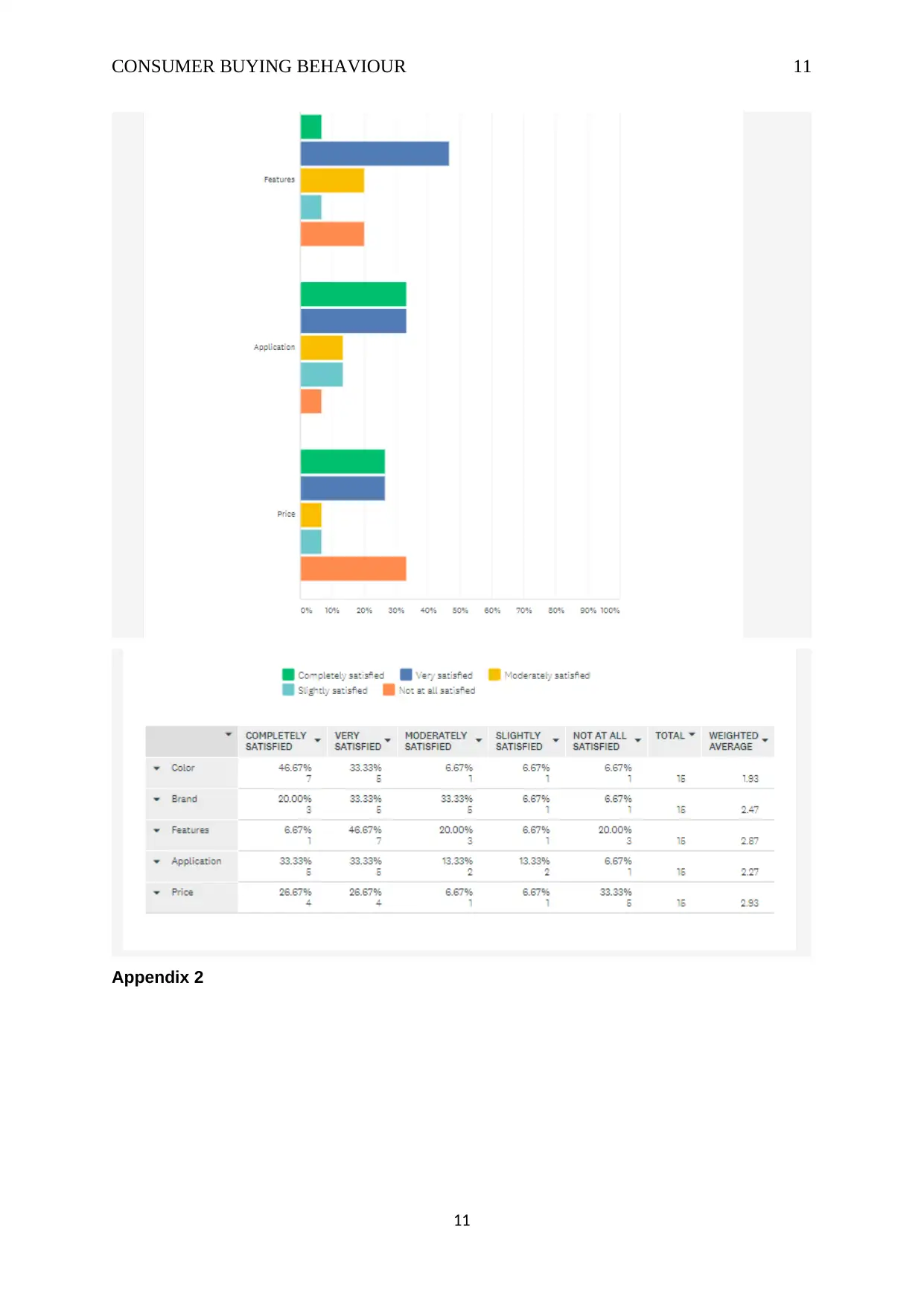
CONSUMER BUYING BEHAVIOUR 11
Appendix 2
11
Appendix 2
11
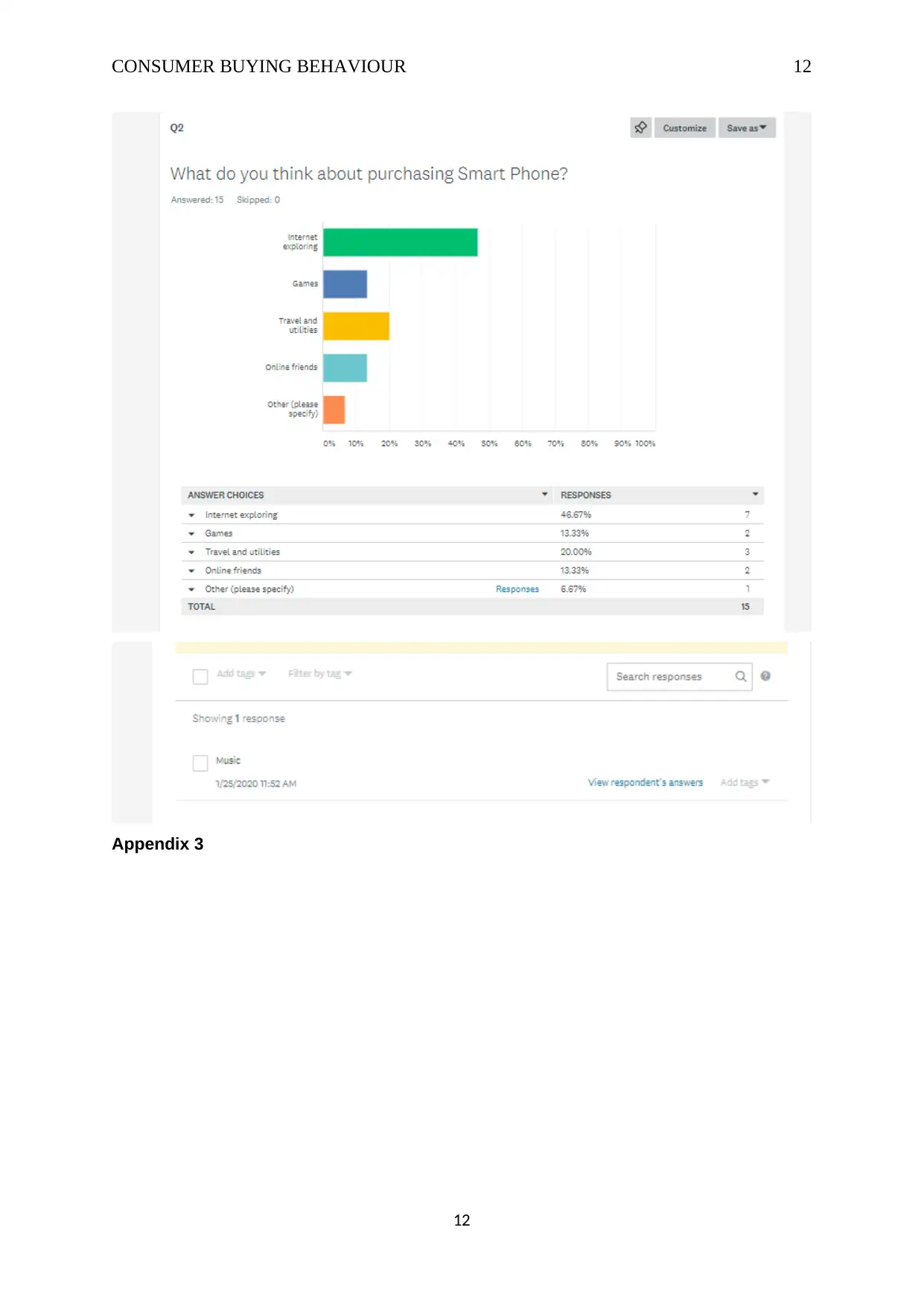
CONSUMER BUYING BEHAVIOUR 12
Appendix 3
12
Appendix 3
12
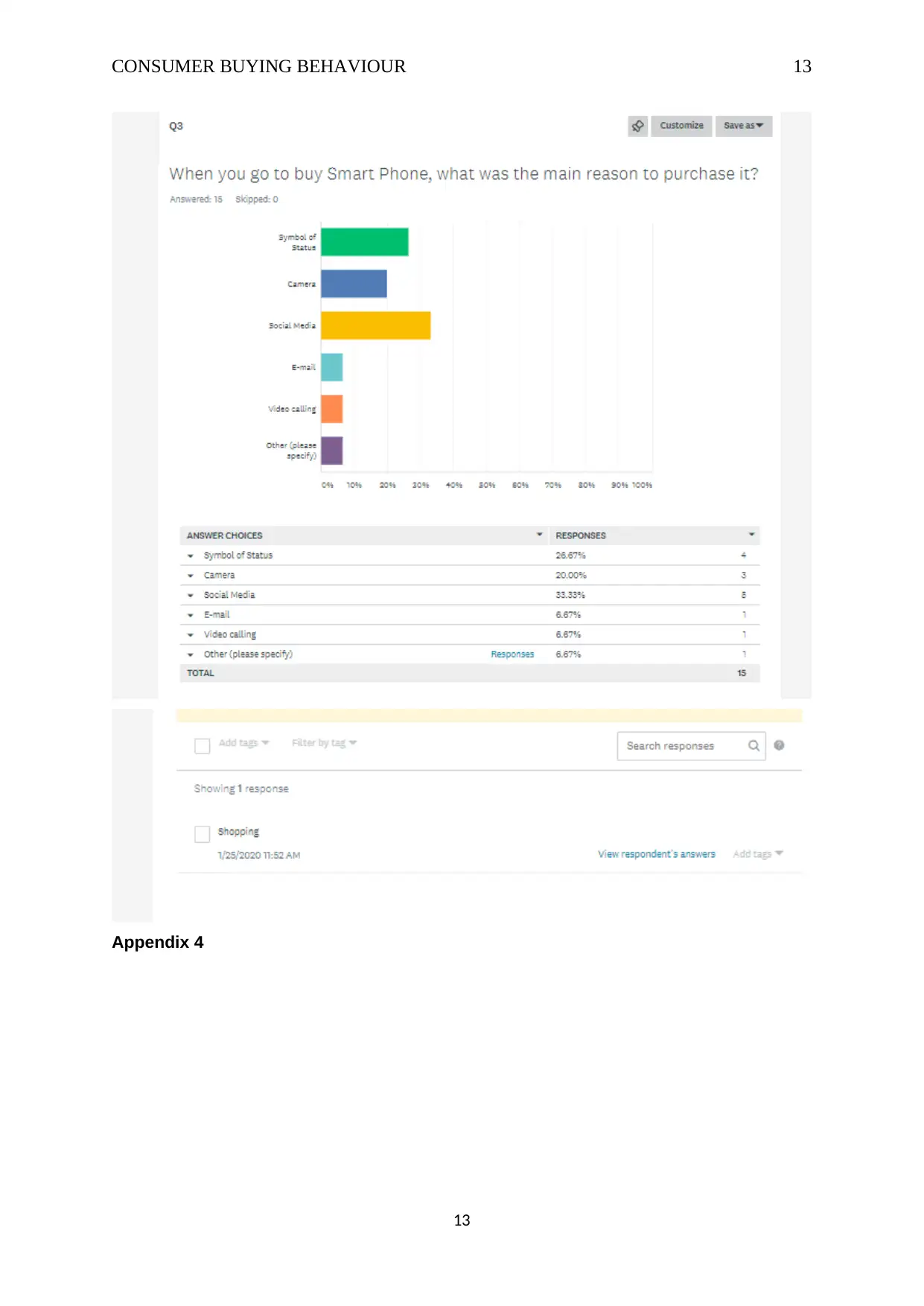
CONSUMER BUYING BEHAVIOUR 13
Appendix 4
13
Appendix 4
13
Paraphrase This Document
Need a fresh take? Get an instant paraphrase of this document with our AI Paraphraser
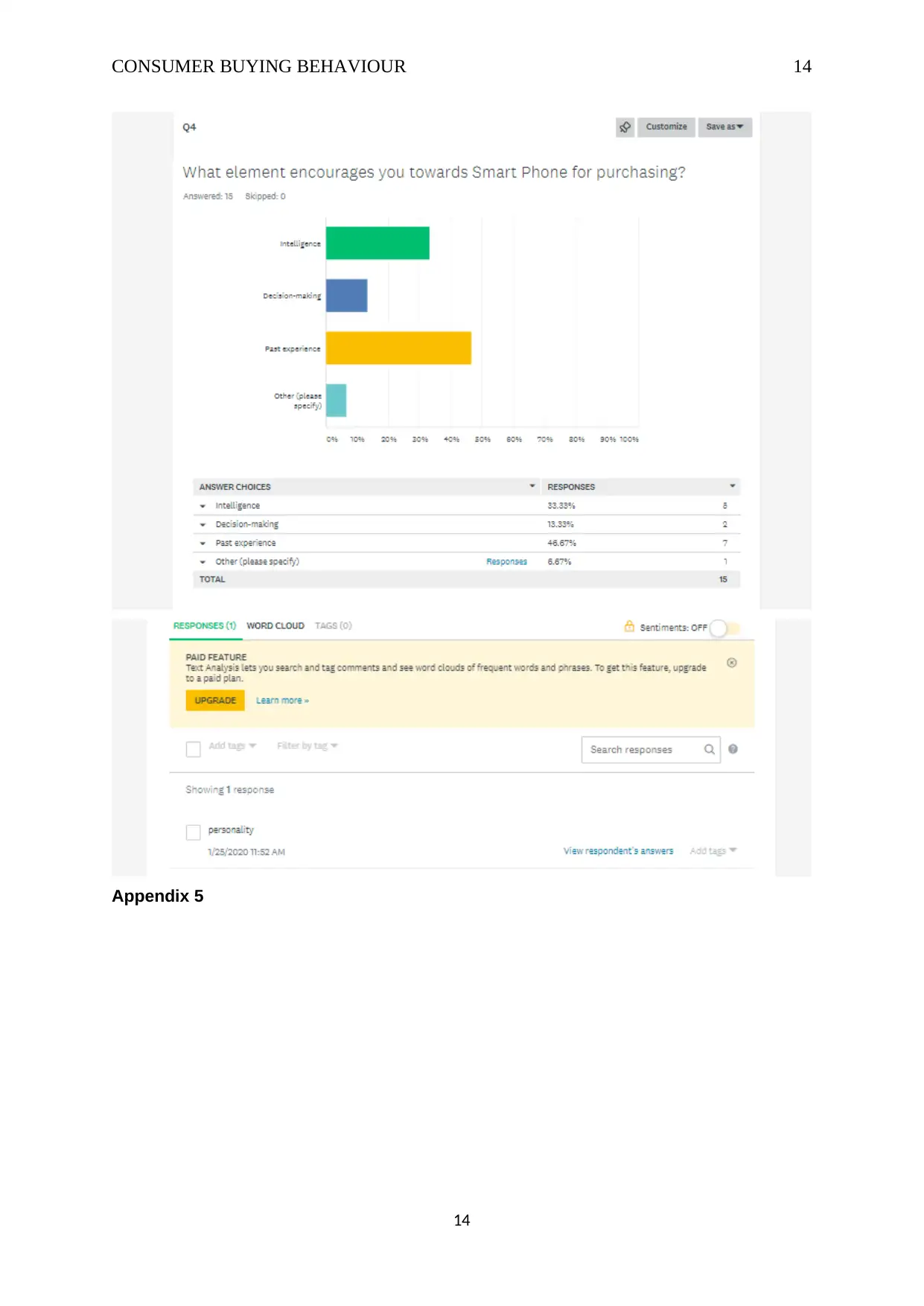
CONSUMER BUYING BEHAVIOUR 14
Appendix 5
14
Appendix 5
14
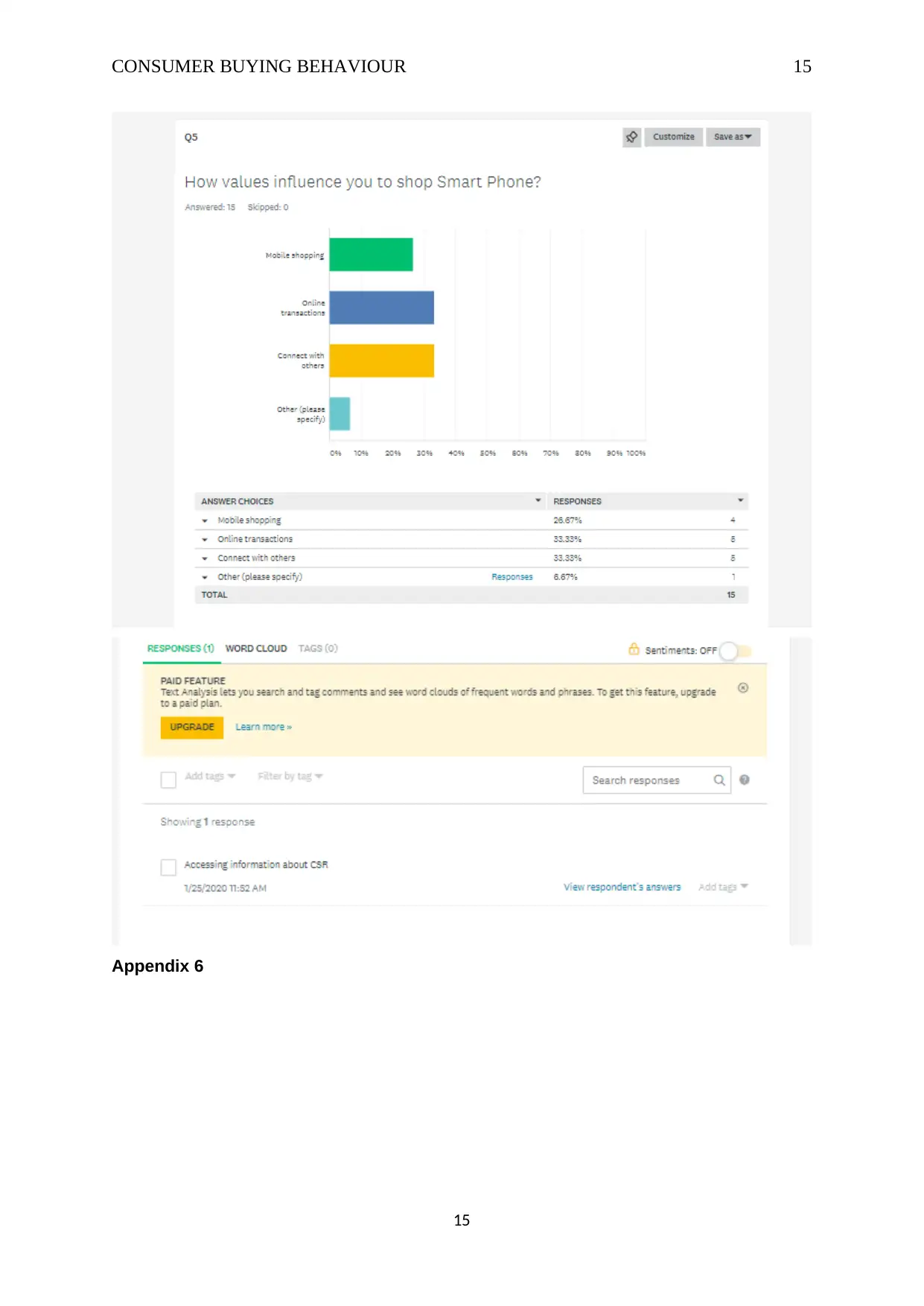
CONSUMER BUYING BEHAVIOUR 15
Appendix 6
15
Appendix 6
15
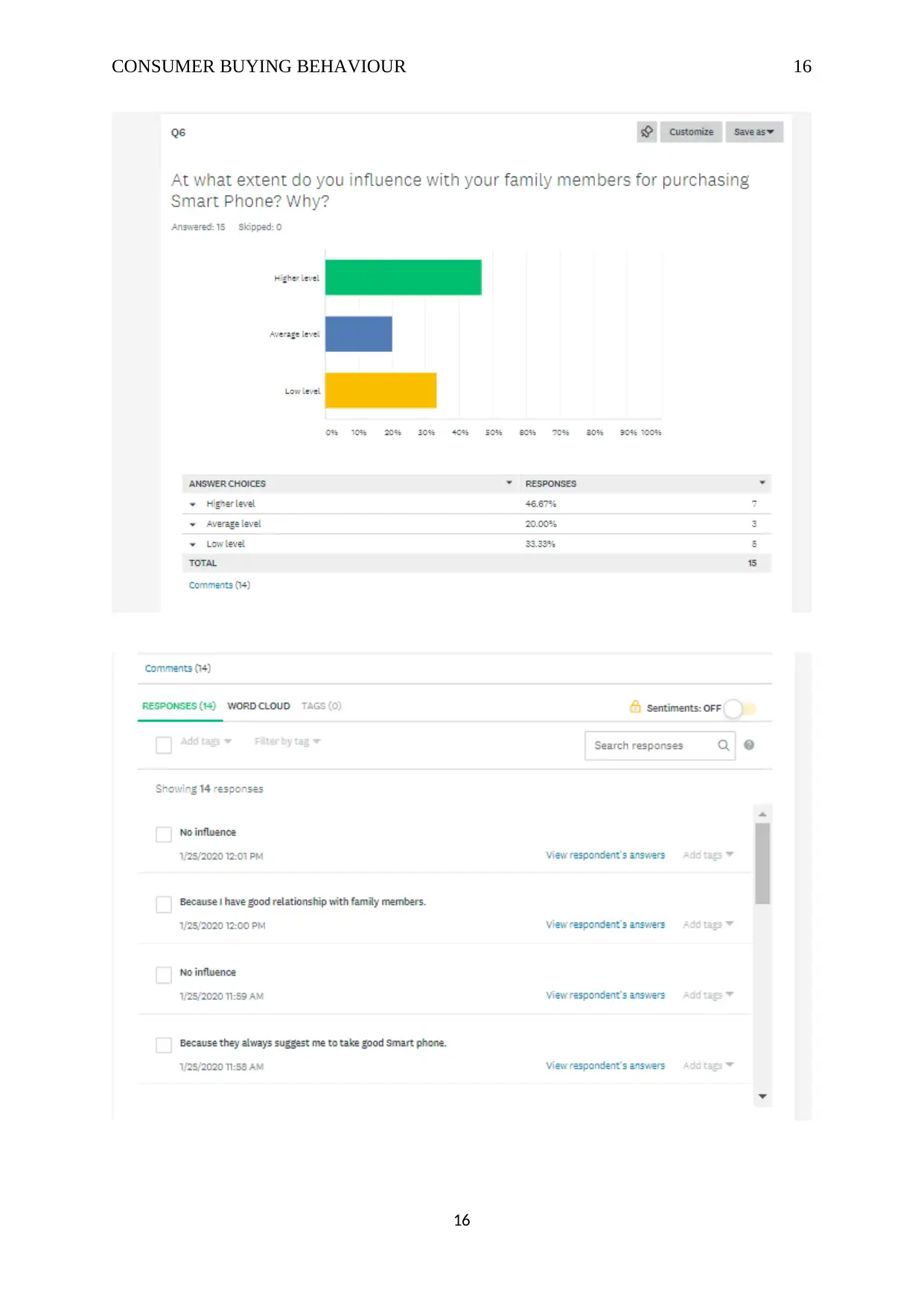
CONSUMER BUYING BEHAVIOUR 16
16
16
Secure Best Marks with AI Grader
Need help grading? Try our AI Grader for instant feedback on your assignments.
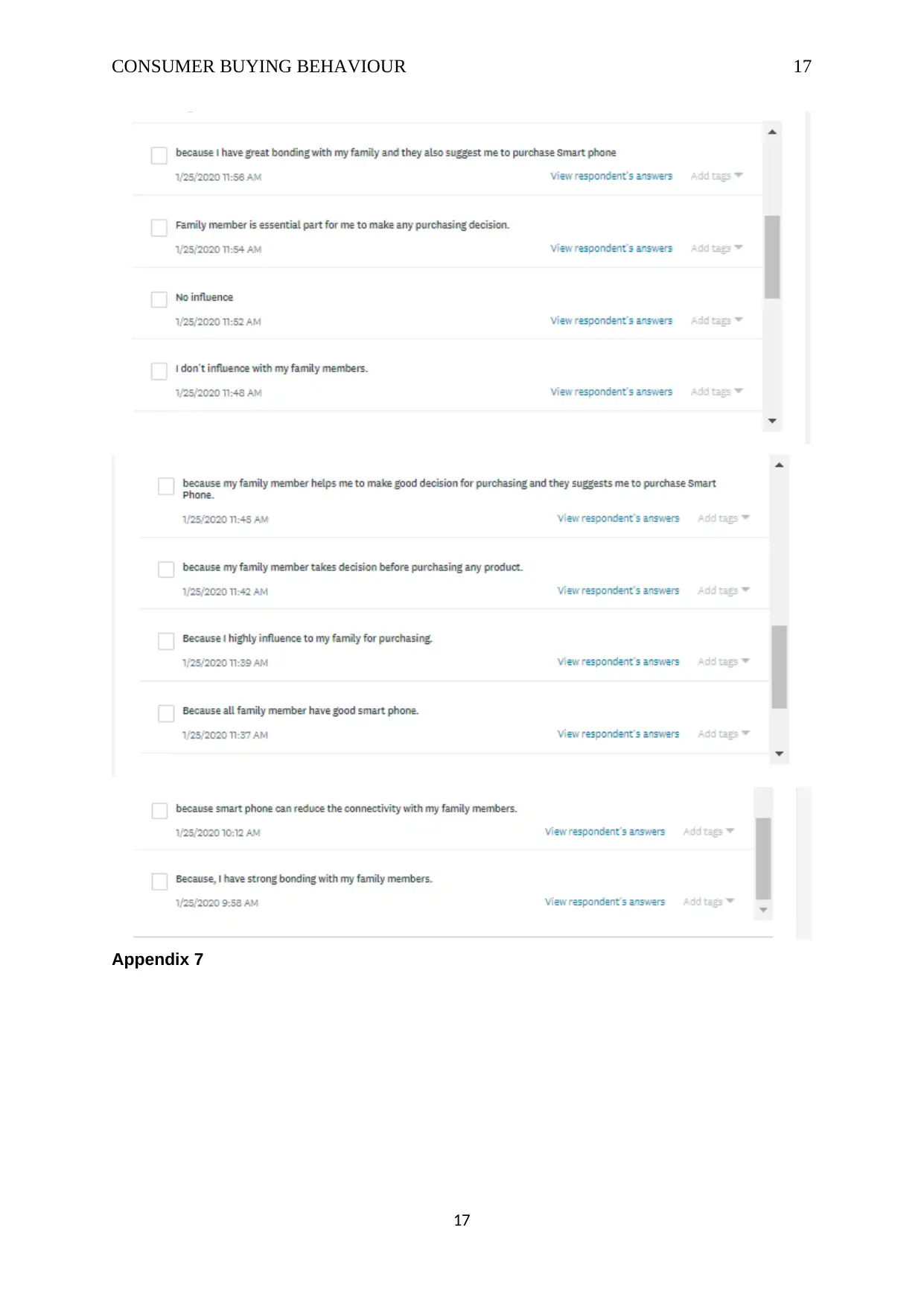
CONSUMER BUYING BEHAVIOUR 17
Appendix 7
17
Appendix 7
17
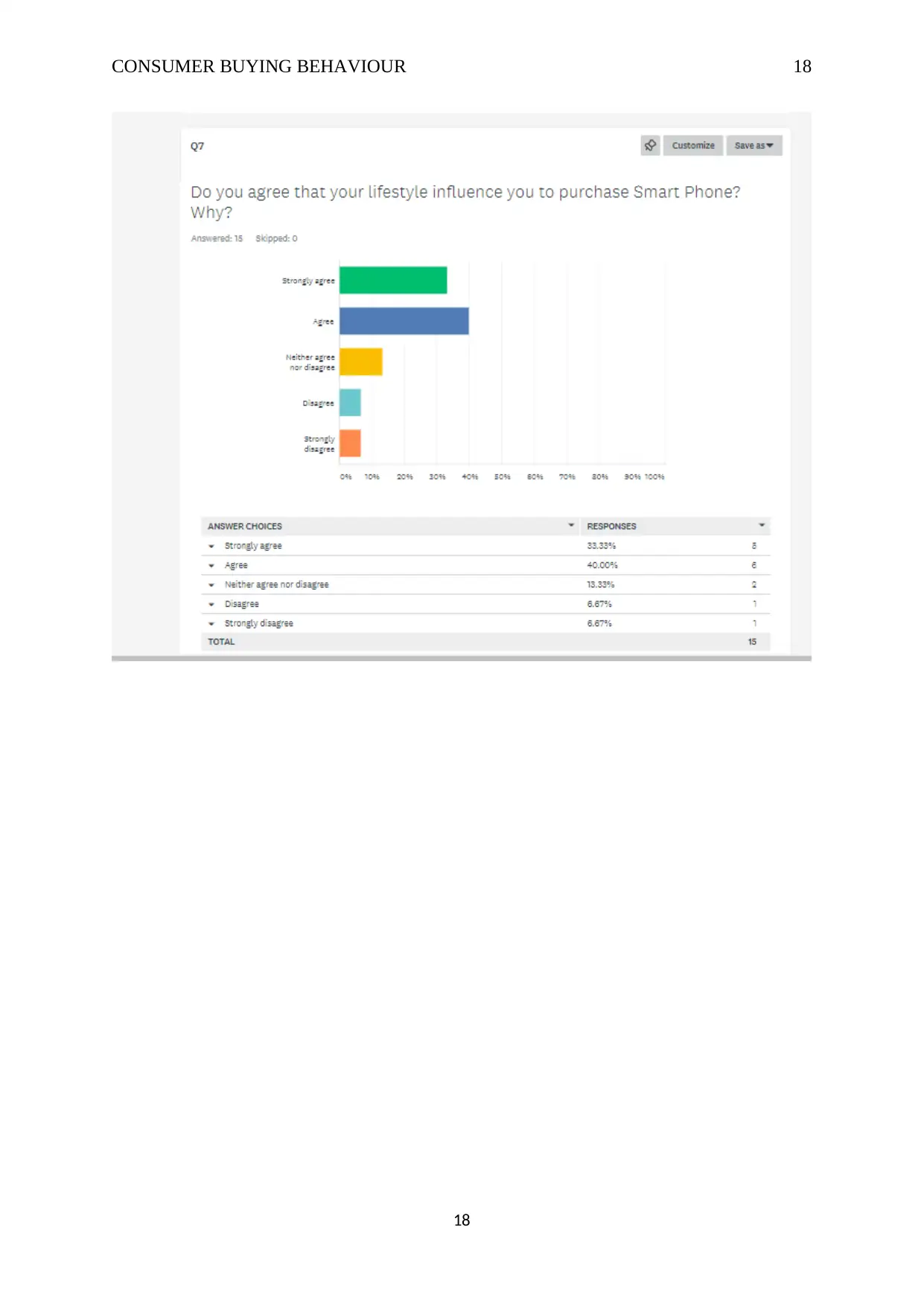
CONSUMER BUYING BEHAVIOUR 18
18
18
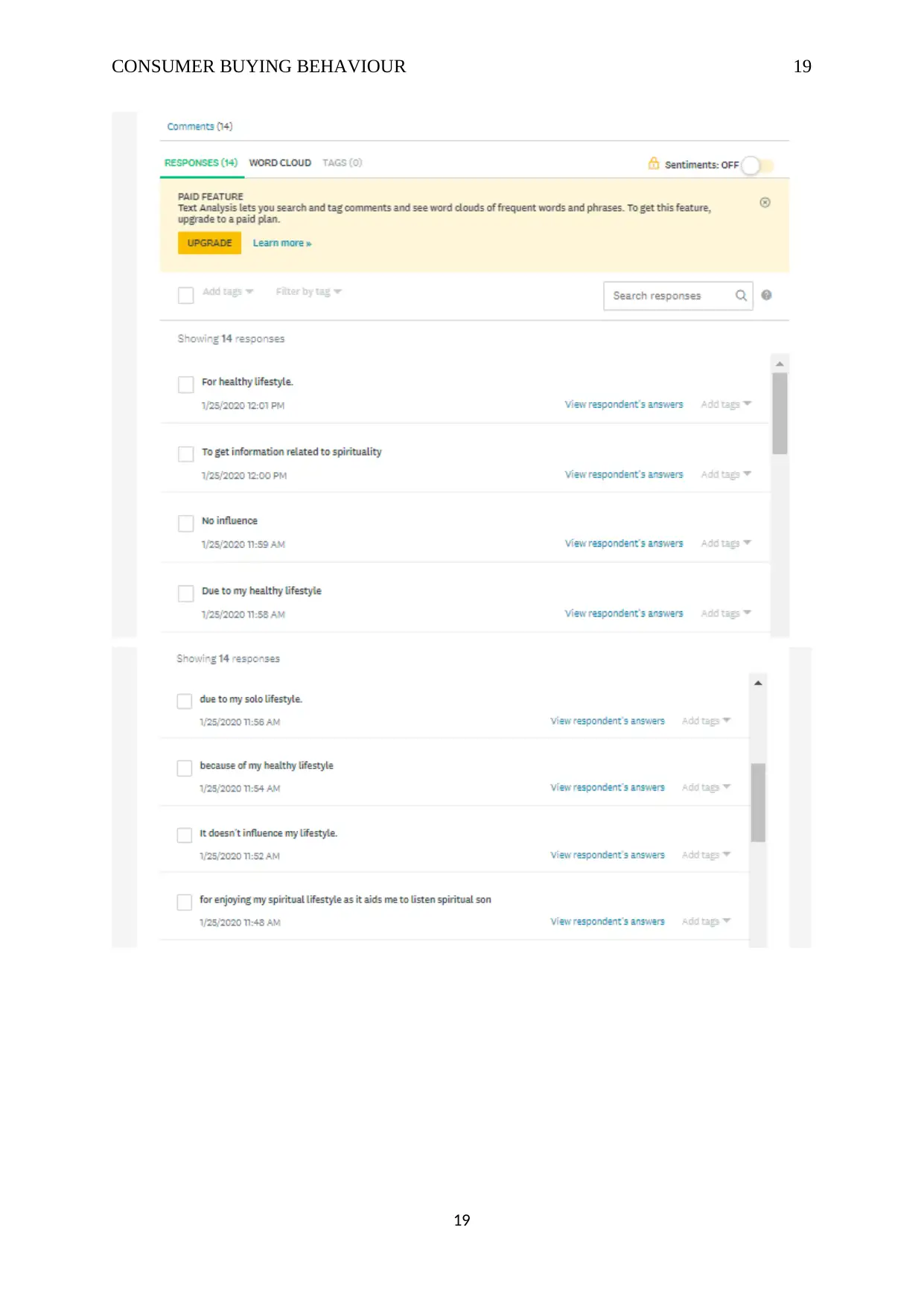
CONSUMER BUYING BEHAVIOUR 19
19
19
Paraphrase This Document
Need a fresh take? Get an instant paraphrase of this document with our AI Paraphraser
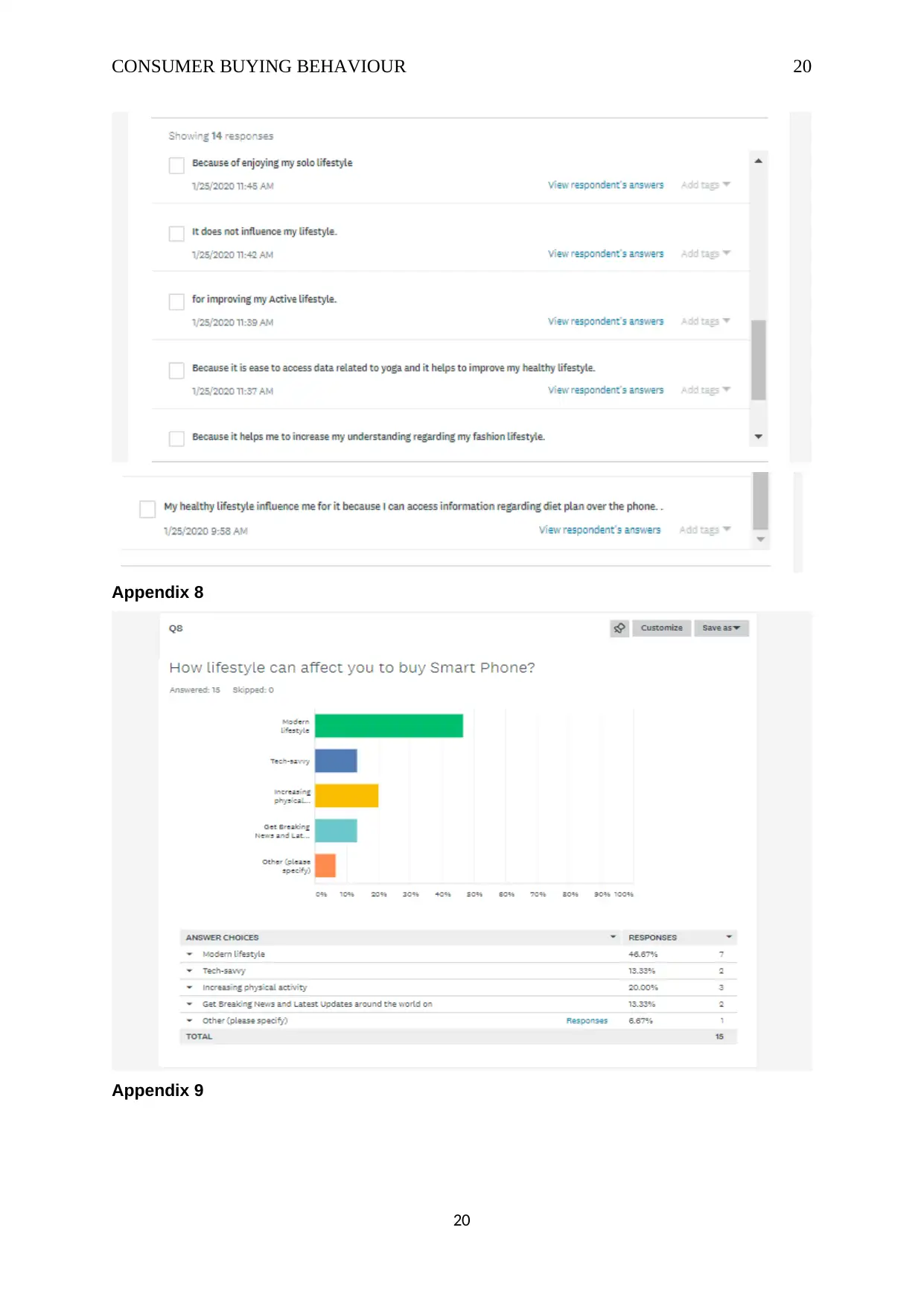
CONSUMER BUYING BEHAVIOUR 20
Appendix 8
Appendix 9
20
Appendix 8
Appendix 9
20
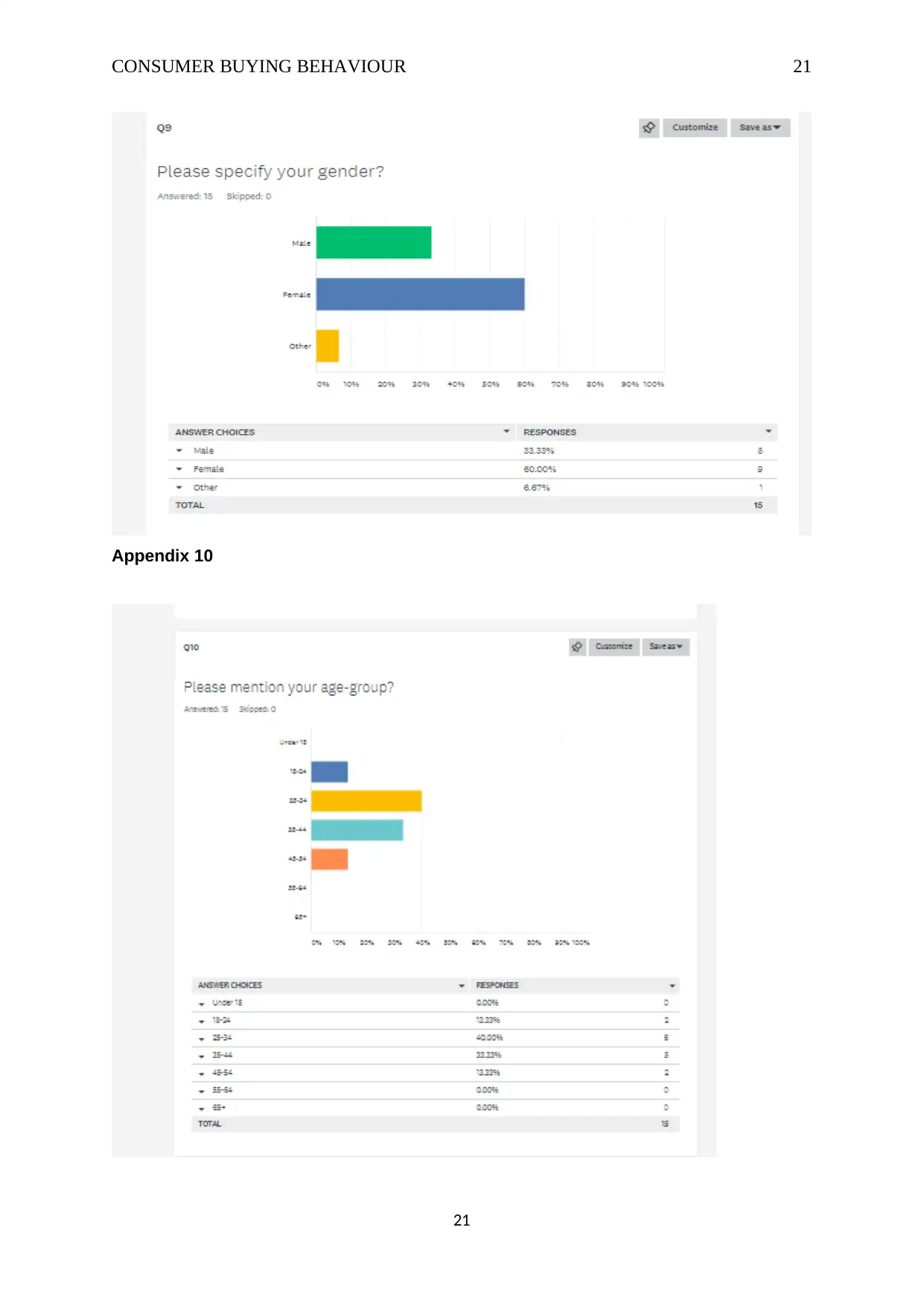
CONSUMER BUYING BEHAVIOUR 21
Appendix 10
21
Appendix 10
21
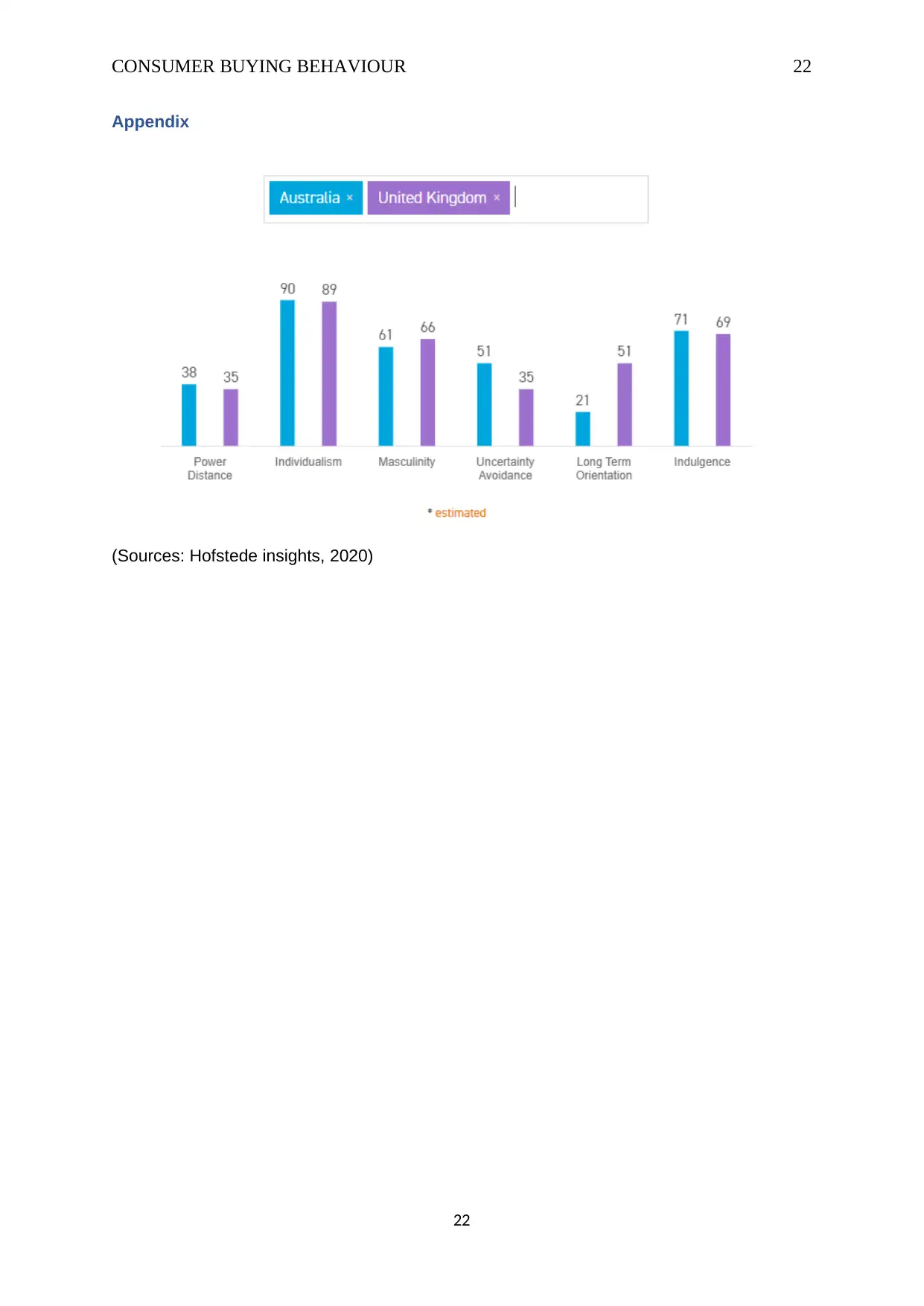
CONSUMER BUYING BEHAVIOUR 22
Appendix
(Sources: Hofstede insights, 2020)
22
Appendix
(Sources: Hofstede insights, 2020)
22
1 out of 22
Related Documents
Your All-in-One AI-Powered Toolkit for Academic Success.
+13062052269
info@desklib.com
Available 24*7 on WhatsApp / Email
![[object Object]](/_next/static/media/star-bottom.7253800d.svg)
Unlock your academic potential
© 2024 | Zucol Services PVT LTD | All rights reserved.





